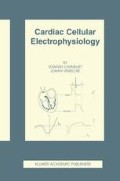Abstract
Many different types of channels have been found in cardiac tissue [see 145,754,1087,1340,1356], and a huge literature exists on cardiac ion channels since cardiac electrophysiology started around 1949, when Coraboeuf and Weidmann registered the first cardiac action potentials with an intracellular electrode [209]. However, for obvious reasons most of the investigations have not been performed on human hearts, but on hearts from different types of animals. Data from human cardiac cells or from channels cloned from human hearts have only recently become more abundant. From the electrophysiological studies it is clear that large interspecies variability exists and that caution must be exerted when extrapolating data obtained in animals to the human heart. In this chapter we provide a general, though far from exhausting overview of the properties of ion channels that have been found in mammalian hearts. Our aim is to give a general overview of cardiac ion channels in order to provide insight in the mechanisms governing electrical activity, and to discuss how ion channels determine electrical and mechanical activity of the heart. Our emphasis is on channels that have been described in human hearts or are found to be present in most mammalian species investigated, and which appear to have an important role in physiological and pathological conditions. The channels which are most important for normal electrical activity in the heart are the voltage-dependent Na+channel, the L- and T-type Ca2+channels, the inward-rectifying K+channel, the delayed rectifying K+channels, the transient outward current, the ifpacemaker current and the acetylcholine-sensitive K+current. Modulation and pharmacological properties of channels [for review see 148] and also changes in disease [145] and remodeling [790,1116] are only briefly mentioned in this chapter, since they are treated more extensively in later chapters.
Access this chapter
Tax calculation will be finalised at checkout
Purchases are for personal use only
Preview
Unable to display preview. Download preview PDF.
Author information
Authors and Affiliations
Rights and permissions
Copyright information
© 2002 Springer Science+Business Media New York
About this chapter
Cite this chapter
Carmeliet, E., Vereecke, J. (2002). Ionic currents and action potentials in cardiac cells. In: Cardiac Cellular Electrophysiology. Basic Science for the Cardiologist, vol 9. Springer, Boston, MA. https://doi.org/10.1007/978-1-4615-1715-3_4
Download citation
DOI: https://doi.org/10.1007/978-1-4615-1715-3_4
Publisher Name: Springer, Boston, MA
Print ISBN: 978-1-4613-5692-9
Online ISBN: 978-1-4615-1715-3
eBook Packages: Springer Book Archive

